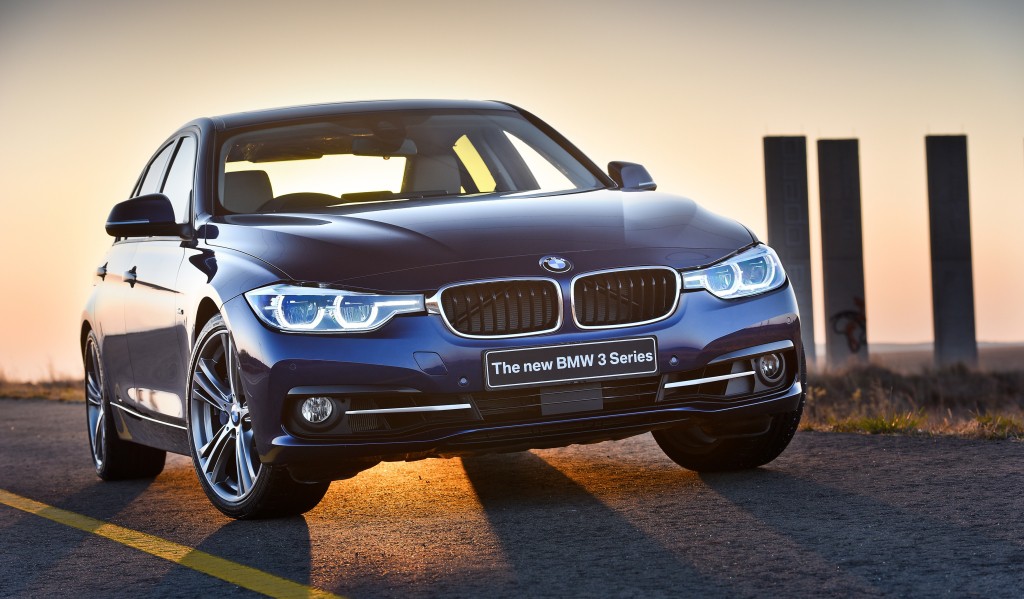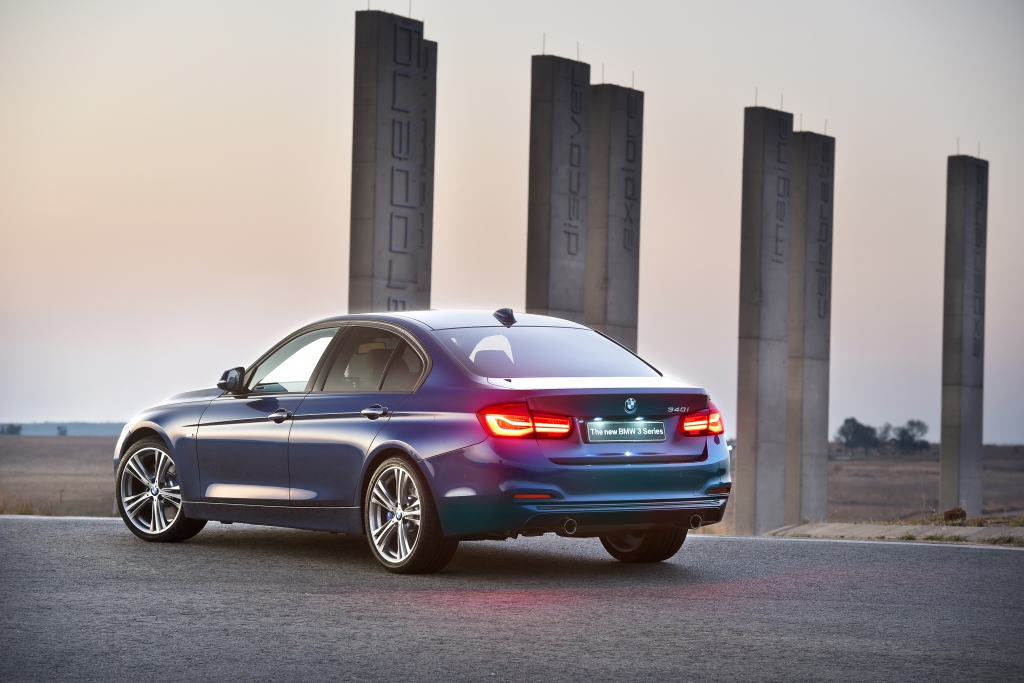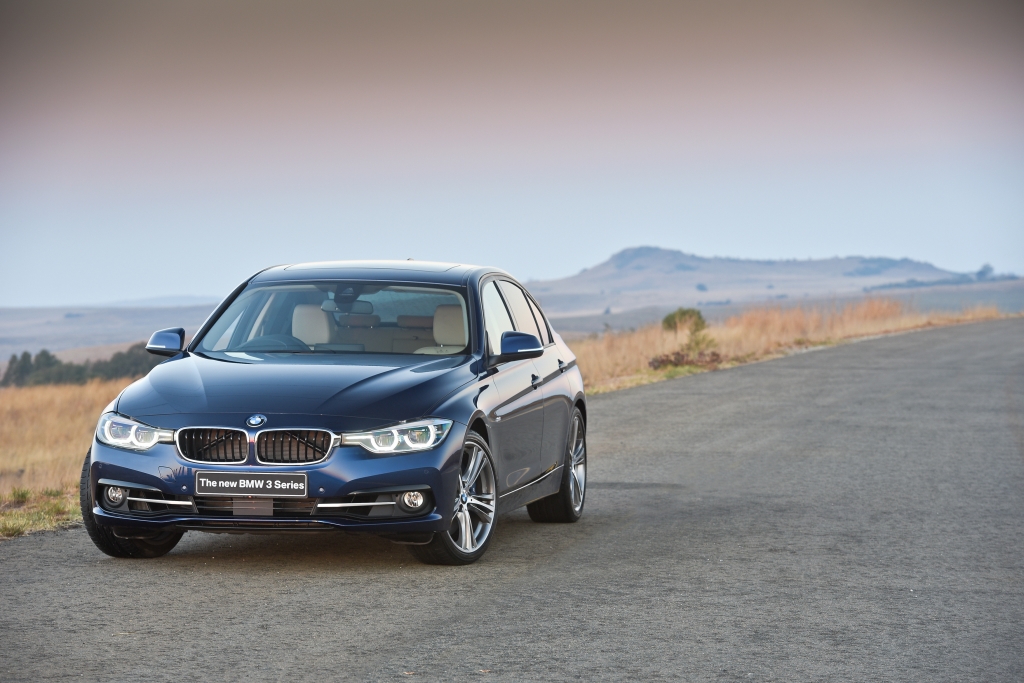BMW’s venerable 3 Series sports sedan turns 40 years old this year, and now, more than ever before, it needs to be the best it can be. Never before in its 40 year reign in the segment has the 3 Series’ crown been under threat as much as it is now. With that in mind, the midlife refresh of the 6th-gen 3 Series (F30 LCI) has a lot riding on it being a success.
It’s for this reason that BMW has kept the styling changes to a minimum. Slight tweaks to the exterior include broader air intakes on the front end, along with slightly redesigned headlight clusters that feature ‘eyebrow’ indicators, and revised Corona-ring daytime running lights – which although only tweaked slightly, make for a striking image on the road. The rear lights are now full-LED units, with slight changes to their shape. Other than that, the only design changes to the exterior come on the 320i, which now features twin tailpipes to match that of the 330i, itself replacing the 328i.
Inside, the changes are a touch more obvious. The overall design is a familiar one, but BMW has enhanced the overall feel of class by adding gloss black plastics in the centre of the dash, control console, and on the door panels. The front cup holder now benefits from a new sliding cover and an additional storage binnacle – revolutionary stuff. The rest of the tweaks are beneath the surface, including enhanced usability on the infotainment module, with free map updates available from the dealership to vehicles equipped with navigation.
But whilst the styling has remained much the same – if it’s broken, why fix it – beneath the skin BMW has taken care to make sure the 3 Series isn’t outgunned by the likes of the new C Class, Jaguar XE, and forthcoming Audi A4. The suspension has been revised rather heavily, with revised dampers and stiffer suspension to ensure better road holding and higher levels of comfort. Revised steering has been developed to be more precise, along with the option of Servotronic – BMW’s variable ratio electronic steering system (more on that later).
The biggest sub-surface change though, is the engine line-up. It’s almost all new (and all EU6-compliant), with only the 330d retaining the engine of its forebear. 4 petrols and 2 diesels make up the full line-up at present, with a 330e plug-in hybrid due to arrive next year.
At the lower end of the petrol segment, BMW has swapped out the 316i with a 318i as an entry level model, equipping it with a 100kW and 220Nm 1.5-litre 3-cylinder turbo engine. Slotting in above that is the ever-present 320i, equipped with a new modular 2.0-litre turbo 4-cylinder outputting 135kW and 290Nm. The 328i is replaced with the revival of the 330i nomenclature, and features an upgrade of the 320i’s engine developing 185kW and 350Nm. Topping the range of petrol-powered models is the new 340i – replacing the 335i – with outputs of 240kW and 450Nm and capable of performing the 0-100km/h sprint in 5.1 seconds with the 8-speed Sports Automatic Steptronic transmission.
The diesel line-up is comprised of an entry level 320d, powered by a 4-cylinder turbo-diesel 2-litre generating 140kW and 400Nm – capable of a 7.2s 0-100km/h sprint, as well as the carried-over 330d with outputs of 190kW and 560Nm.
All engines options are available with either a 6-speed manual or 8-speed ZF automatic transmissions – the former of which now features active rev matching on down shifts.
Of course this all means sweet nothing if the 3 Series hasn’t improved on the road. So, has it?
First up, I sampled the new 340i. The new modular 6-cylinder petrol mill, whilst only slightly improved as far as the figures suggest, is all new, both in engineering and in the way it drives. It’s aurally pleasing – both from within the cabin (where the soundtrack is piped in) and without where spectators are guaranteed a low growl and the buttery tune of the inline 6. With peak torque available from 1380rpm, low end grunt is abundant, with a strong pull through the range and a decent tendency to chase the redline with only a slight plateau when peak power occurs between 5500 and 6500rpm. It’s buttery smooth, this 6 banger, and lives up to BMW’s heritage of building great inline 6s.
The revised suspension and dampers are the highlight of the revised 3er though. The dampers respond better at both low and high speeds to help the wheels maintain contact with the road at all times. Front end grip is particularly improved, reducing the trace understeer that at times haunted the pre-face lift 3er, and the rear remains glued to the road unless rigorously provoked with aggressive throttle use. When provoked though, the 3 Series reminds why it’s been the sports sedan to beat for 4 decades though – the chassis balance is still as superb as ever, even under duress.
The model we tested, though, was equipped with BMW’s Servotronic with variable ratio electronic steering. This is perhaps the greatest fault to the new 3’s technology improvements. Whilst the idea is clever – at slower speeds, lesser input results in greater amounts of turn and at higher speeds, more input is required – the results it produces are difficult to read at the best of times. Through groupings of twists and turns, each curve sees the 3 behave differently depending on entry speed, and worst of all the heavily computerised system robs the driver of any mechanical feel that could be had.
Being highly capable, one can rely on the 3’s ability through corners, but it’s highly disconcerting to say the least, not being able to rely on one’s own sensitivity. It was only when I swapped 6-cylinders for 4 and a 40i suffix for a 20i with a standard electronic steering system that the variable ratio’s faults became glaringly obvious.
The standard setup is the one to opt for if you’re of purer driving ilk – and although not wholly full of full of feel, it still grants masses of communication as to where the front wheels are and how much lock you can wind on or unwind depending on the turn ahead. That said, it isn’t a clear market leader as far as steering feel goes – as it seems matched (from memory) by the C Class and bested by the Jaguar XE.
As far as the rest of the 320i package goes, engine wise, the new motor is sweeter than the one it replaces. It pulls strongly, although with none of the kidney-bruising force of the 340i – peak torque arrives at 1350rpm and peak power between 5000 and 6500rpm, and unlike the 40i is prone to a flatter power delivery near the redline. Fuel consumption is particularly impressive though – claimed at 5.5l/100km on a combined cycle – even under duress it never climbed beyond 9.9l100km on my launch drive.
40 years on and I’d be lying if I said the BMW 3 Series isn’t still a fantastic sports sedan that’s hard to fault. But is it still the definitive sports sedan, I’m not so sure. I can’t say outright that the 3 has been beaten, without a back to back test against its competitors, but never in its 40 year reign has the 3 Series been in more danger than it is now.
Pricing:
| 318i | R409 000 (With 6-speed manual) |
| 320i | R443 000 (With 6-speed manual) |
| 320d | R472 000 (With 6-speed manual) |
| 330i | R516 000 (With 6-speed manual) |
| 330d | R596 000 (with standard 8-speed auto) |
| 340i | R671 200 (with standard 8-speed Sports auto) |
Limited edition #40YearsOf3 package:
Celebrating 40 years of the 3 Series, BMW South Africa has devised a special 40 Years of 3 package that will be available in a limited number of 400 units. The package adds on a cost of R50 000 and is available for equipment to all models from the 320i upwards. Included in the package, which starts off as a basic M-Sport, is specialised paint, custom one-off alloy wheels, silver window surrounds, and a specialised dashboard plaque celebrating the 40th anniversary of the iconic sports sedan.











